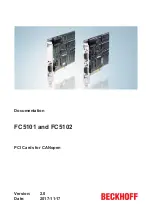
Fitting and wiring
FC5101 and FC5102
14
Version: 2.0
3.2
CANopen cabling
Notes related to checking the CAN wiring can be found in the
3.2.1
CAN topology
CAN is a 2-wire bus system, to which all participating devices are connected in parallel (i.e. using short drop
lines). The bus must be terminated at each end with a 120 (or 121) Ohm terminating resistor to prevent
reflections. This is also necessary even if the cable lengths are very short!
Fig. 7: Termination of the bus with a 120 Ohm termination resistor
Since the CAN signals are represented on the bus as the difference between the two levels, the CAN leads
are not very sensitive to incoming interference (EMI): Both leads are affected, so the interference has very
little effect on the difference.
Fig. 8: Insensitivity to incoming interference
3.2.2
Bus length
The maximum length of a CAN bus is primarily limited by the signal propagation delay. The multi-master bus
access procedure (arbitration) requires signals to reach all the nodes at effectively the same time (before the
sampling within a bit period). Since the signal propagation delays in the CAN connecting equipment
(transceivers, opto-couplers, CAN controllers) are almost constant, the line length must be chosen in
accordance with the baud rate:
Baud rate
Bus length
1 Mbit/s
< 20 m*
500 kbit/s
< 100 m
250 kbit/s
< 250 m
125 kbit/s
< 500 m
50 kbit/s
< 1000 m
20 kbit/s
< 2500 m
10 kbit/s
< 5000 m
Содержание FC5101
Страница 1: ...Documentation FC5101 and FC5102 PCI Cards for CANopen 2 0 2017 11 17 Version Date...
Страница 2: ......















































